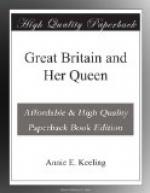It was indeed a happy day for England when Edward, Duke of Kent, the fourth son of George III, was wedded to Victoria of Saxe-Coburg, the widowed Princess of Leiningen—happy, not only because of the admirable skill with which that lady conducted her illustrious child’s education, and because of the pure, upright principles, the frank, noble character, which she transmitted to that child, but because the family connection established through that marriage was to be yet further serviceable to the interests of our realm. Prince Albert of Saxe-Coburg was second son of the Duchess of Kent’s eldest brother, and thus first cousin of the Princess Victoria—“the Mayflower,” as, in fond allusion to the month of her birth, her mother’s kinsfolk loved to call her: and it has been made plain that dreams of a possible union between the two young cousins, very nearly of an age, were early cherished by the elders who loved and admired both.
[Illustration: Duchess of Kent. From an Engraving by Messrs. P. & D. Colnaghi & Co., Pall Mall East.]
The Princess’s life, however, was sedulously guarded from all disturbing influences. She grew up in healthy simplicity and seclusion; she was not apprised of her nearness to the throne till she was twelve years old; she had been little at Court, little in sight, but had been made familiar with her own land and its history, having received the higher education so essential to her great position; while simple truth and rigid honesty were the very atmosphere of her existence. From such a training much might be hoped; but even those who knew most and hoped most were not quite prepared for the strong individual character and power of self-determination that revealed themselves in the girlish being so suddenly transferred “from the nursery to the throne.” It was quickly noticed that the part of Queen and mistress seemed native to her, and that she filled it with not more grace than propriety. “She always strikes me as possessed of singular penetration, firmness, and independence,” wrote Dr. Norman Macleod in 1860; acute observers in 1837 took note of the same traits, rarer far in youth than in full maturity, and closely connected with the “reasoning, searching” quality of her mind, “anxious to get at the root and reality of things, and abhorring all shams, whether in word or deed.” [Footnote]




